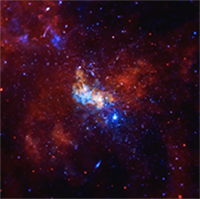Black Holes and Vacuum Cleaners: Using Metaphors to Explain Space Images
Scientific imagery, especially those from space, can be both powerful and beautiful. The images created by professional and amateur astronomers alike are often striking. This gives science communicators an opportunity to use such images as an access point for the related subject matter. In other words, scientific images are a door through which we can walk towards the discoveries and insight that science can achieve.
The Aesthetics & Astronomy project (A&A) is a unique research project that aims to study exactly how people from different backgrounds and educational experiences interpret and interact with scientific imagery. Started at the Chandra X-ray Center and combining the expertise of astrophysicists, psychologists, image producers, and educators specializing in research methodology, A&A delves into how these images can be used as a vehicle for scientific information.
One question that A&A recently asked is: how effective are metaphors in communicating scientific results? To explore this question, the A&A project solicited input from nearly 2,000 participants and asked a series of questions through an online study. After presenting participants with four astronomical images — Sagittarius A*, Our Sun (solar flare), Cassiopeia A, and the Pinwheel Galaxy — they were shown three separate labels for each.

Cassiopeia A
Credit: NASA/CXC/SAO

Our Sun: solar flare
Credit: NASA/GSFC/SDO

Sagittarius A*
Credit: NASA/CXC/Univ. of
Wisconsin/Y. Bai et al.

Pinwheel Galaxy (M101)
Credit: NASA, ESA, K. Kuntz (JHU),
F. Bresolin (Univ. Hawaii), J. Trauger
(JPL), J. Mould (NOAO), Y.-H. Chu
(Univ. Illinois, Urbana), STScI
The result is a fascinating reservoir of information that explores how the text accompanying an image of space can influence understanding and excitement of that image. To put it another way, you can keep an image the same, but changing the text with it can affect how we all see and appreciate the data. It's also interesting to note that the platform we view these images on — a smartphone vs. a computer screen, for example, — plays into perceptions of the science images and text.
For those interested in communicating science, this latest A&A study has a wealth of information to consider. If you are interested in learning more, you will be able to find the recently accepted research paper, entitled "Black Holes and Vacuum Cleaners: Using Metaphor, Relevance, and Inquiry in Labels for Space Images" by L. Smith, K. Arcand, et al., in a special issue of Psychology of Aesthetics, Creativity, and the Arts (PACA) to be published in the first half of 2017.
View a self-archived copy of the paper at https://arxiv.org/abs/1703.02927
-Megan Watzke, CXC
Please note this is a moderated blog. No pornography, spam, profanity or discriminatory remarks are allowed. No personal attacks are allowed. Users should stay on topic to keep it relevant for the readers.
Read the privacy statement
